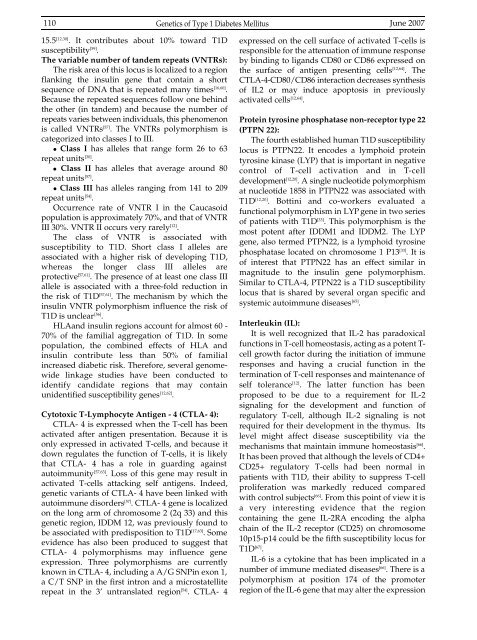Vol 39 # 2 June 2007 - Kma.org.kw
Vol 39 # 2 June 2007 - Kma.org.kw
Vol 39 # 2 June 2007 - Kma.org.kw
- No tags were found...
Create successful ePaper yourself
Turn your PDF publications into a flip-book with our unique Google optimized e-Paper software.
110Genetics of Type 1 Diabetes Mellitus <strong>June</strong> <strong>2007</strong>1 5 . 5 [ 1 2 , 3 0 ] . It contributes about 10% toward T1Dsusceptibility [59] .The variable number of tandem repeats (VNTRs):The risk area of this locus is localized to a regionflanking the insulin gene that contain a shortsequence of DNA that is repeated many times [16,60] .Because the repeated sequences follow one behindthe other (in tandem) and because the number ofrepeats varies between individuals, this phenomenonis called VNTRs [57] . The VNTRs polymorphism iscategorized into classes I to III.• Class I has alleles that range form 26 to 63repeat units [30] .• Class II has alleles that average around 80repeat units [57] .• Class III has alleles ranging from 141 to 209repeat units [54] .Occurrence rate of VNTR I in the Caucasoidpopulation is approximately 70%, and that of VNTRI I I 30%. VNTR II occurs very rarely [12] .The class of VNTR is associated withsusceptibility to T1D. Short class I alleles areassociated with a higher risk of developing T1D,w h e reas the longer class III alleles areprotective [57,61] . The presence of at least one class IIIallele is associated with a three-fold reduction inthe risk of T1D [57,61] . The mechanism by which theinsulin VNTR polymorphism influence the risk ofT1D is unclear [56] .HLAand insulin regions account for almost 60 -70% of the familial aggregation of T1D. In somepopulation, the combined effects of HLA a n dinsulin contribute less than 50% of familialincreased diabetic risk. Therefore, several genomewidelinkage studies have been conducted toidentify candidate regions that may containunidentified susceptibility genes [12,62] .Cytotoxic T-Lymphocyte Antigen - 4 (CTLA- 4):CTLA- 4 is expressed when the T-cell has beenactivated after antigen presentation. Because it isonly expressed in activated T-cells, and because itdown regulates the function of T-cells, it is likelythat CTLA- 4 has a role in guarding againstautoimmunity [57,63] . Loss of this gene may result inactivated T-cells attacking self antigens. Indeed,genetic variants of CTLA- 4 have been linked withautoimmune disorders [57] . CTLA- 4 gene is localizedon the long arm of chromosome 2 (2q 33) and thisgenetic region, IDDM 12, was previously found tobe associated with predisposition to T1D [17,63] . Someevidence has also been produced to suggest thatCTLA- 4 polymorphisms may influence genee x p ression. Three polymorphisms are curre n t l yknown in CTLA- 4, including a A/G SNPin exon 1,a C/T SNP in the first intron and a microstatelliterepeat in the 3’ untranslated region [54] . CTLA- 4expressed on the cell surface of activated T-cells isresponsible for the attenuation of immune responseby binding to ligands CD80 or CD86 expressed onthe surface of antigen presenting cells [ 1 2 , 6 4 ] . TheCTLA-4-CD80/CD86 interaction decreases synthesisof IL2 or may induce apoptosis in pre v i o u s l yactivated cells [12,64] .Protein tyrosine phosphatase non-receptor type 22(PTPN 22):The fourth established human T1D susceptibilitylocus is PTPN22. It encodes a lymphoid proteintyrosine kinase (LYP) that is important in negativec o n t rol of T-cell activation and in T- c e l ld e v e l o p m e n t [ 1 2 , 2 0 ] . A single nucleotide polymorphismat nucleotide 1858 in PTPN22 was associated withT 1 D [ 1 2 , 2 0 ] . Bottini and co-workers evaluated afunctional polymorphism in LYP gene in two seriesof patients with T1D [33] . This polymorphism is themost potent after IDDM1 and IDDM2. The LYPgene, also termed PTPN22, is a lymphoid tyrosinephosphatase located on chromosome 1 P13 [33] . It isof interest that PTPN22 has an effect similar inmagnitude to the insulin gene polymorphism.Similar to CTLA-4, PTPN22 is a T1D susceptibilitylocus that is shared by several <strong>org</strong>an specific andsystemic autoimmune diseases [65] .Interleukin (IL):It is well recognized that IL-2 has paradoxicalfunctions in T-cell homeostasis, acting as a potent T-cell growth factor during the initiation of immuneresponses and having a crucial function in thetermination of T-cell responses and maintenance ofself tolerance [ 1 2 ] . The latter function has beenp roposed to be due to a re q u i rement for IL-2signaling for the development and function ofregulatory T-cell, although IL-2 signaling is notrequired for their development in the thymus. Itslevel might affect disease susceptibility via themechanisms that maintain immune homeostasis [66] .It has been proved that although the levels of CD4+CD25+ regulatory T-cells had been normal inpatients with T1D, their ability to suppress T-cellp roliferation was markedly reduced compare dwith control subjects [66] . From this point of view it isa very interesting evidence that the re g i o ncontaining the gene IL-2RA encoding the alphachain of the IL-2 receptor (CD25) on chromosome10p15-p14 could be the fifth susceptibility locus forT1D [67] .IL-6 is a cytokine that has been implicated in anumber of immune mediated diseases [66] . There is apolymorphism at position 174 of the promoterregion of the IL-6 gene that may alter the expression
















